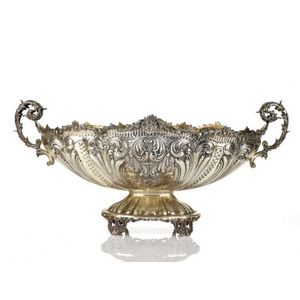Chinese Silver Ewer and Basket with Bamboo Motifs
You must be a subscriber, and be logged in to view price and dealer details.
Subscribe Now to view actual auction price for this item
When you subscribe, you have the option of setting the currency in which to display prices to $Au, $US, $NZ or Stg.
- Oviform /ovoid - The outline loosely resembling the shape of an egg.
- Embossed / Repousse - Embossing, also known as repousse, is the technique of decorating metal with raised designs, by pressing or beating out the design from the reverse side of the object.It is the opposite of chasing, where the decoration is applied from the front. An embossed or repoussed object may have chasing applied to finish off the design.
- Ewer / Pitcher - A type of jug with a narrow neck bulbous body and wide spout, originally used for carrying and storing liquids such as water or wine. In medieval times they were the source of water to wash ones hands during and after a meal. later the shape was used for vessels in silver, gold, glass and ceramics.
In Victorian times they were made in ceramics and occasionally glass with a matching basin, and sometimes other accessories such as a soap holder or toothbrush holder. Their purpose was to provide facilities for personal washing In the early 19th century were often enclosed in purpose built stands, and later resided on a washstand..
Sometimes the words "ewer" and "pitcher" are used interchangably, but a pitcher is generally considered to be a jug, and would have a wide mouth, and a gently tapering body. - Cartouche - An ornamental panel in the form of of a shield, oval or rectangular scroll with curling edges. It may be carved into the back of a chair or the top of a sideboard, or present on a piece of silver or jewellery, and contain the initials of the original owner, heraldic symbols, or some other inscription, such as the details of a presentation.
In ceramics the term defines the central area of a vase or similar with a decorative border in one of the shapes above, into which a decorative scene or figures have been painted.
This item has been included into following indexes:
Visually similar items

A Royal Brierley crystal & silver plate centrepiece, the silver plate frame emanating four arms each supporting four circular cut crystal sweet meat dishes, the body modelled as four acanthus leaves raising a central cut crystal bowl, above a shaped base o

A William IV silver tea and coffee service, John Edward Terrey, London, 1831 and a similar George lV large silver tray, maker probably John Wakefield, London, 1824, (5), comprising a teapot, coffee pot, milk and sugar basin, each of compressed melon form,

A diamond plaque ring, featuring two principal old European cut diamonds of 0.91cts and 0.78cts, set throughout with further diamonds, mounted in 18ct white gold, ring size R

Ettore Leguti via Borromei, Milan c.1975 centrepiece of lobed oval form, the lobes with floral scrollwork, foliate scroll handles raised on an oval foot and four pierced foliate feet, engraved with the words 'Cesselato a mano, AGMA', 800 standard silver, w
